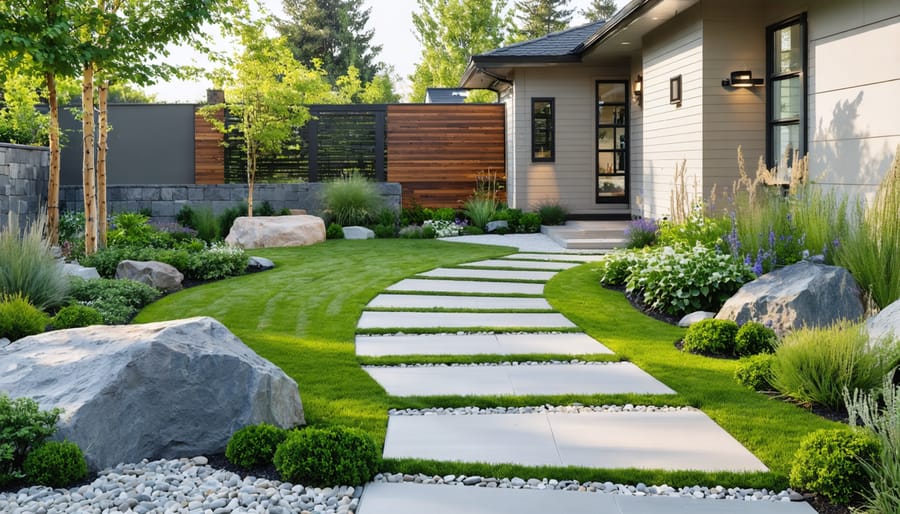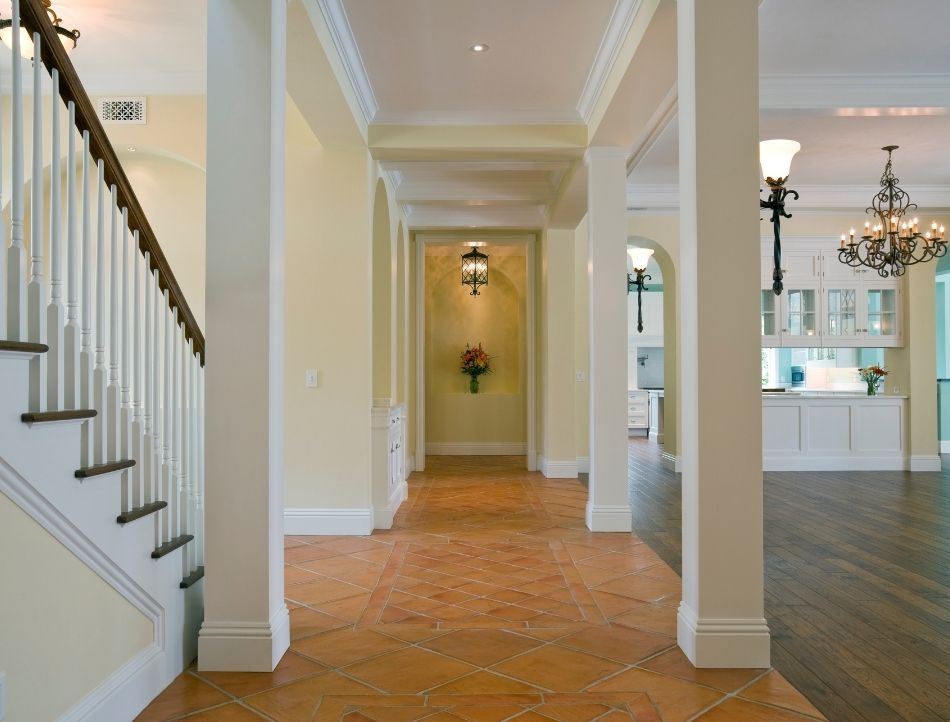Transform your front yard into a self-maintaining oasis by replacing traditional grass with drought-resistant groundcovers like creeping thyme or sedum, installing permeable pavers for a modern aesthetic, and implementing smart irrigation systems that adjust to weather conditions. These eco-friendly landscaping secrets eliminate weekly mowing, reduce water consumption, and create a stunning curb appeal that practically maintains itself. Strategic hardscaping with gravel paths, decorative rocks, and native plants adapted to your local climate creates a sophisticated, low-maintenance landscape that thrives year-round without constant attention. Modern synthetic turf options provide the look of a pristine lawn without the endless cycle of watering, fertilizing, and mowing, while automated lighting systems add security and ambiance without adding to your maintenance routine.
Smart Hardscaping: The Foundation of a Maintenance-Free Yard
Decorative Gravel and Rock Gardens
Transform your front yard into a stunning, maintenance-free landscape with decorative gravel and rock gardens – one of the most popular earth-friendly outdoor solutions available today. When selecting gravel, you have several attractive options to consider: river rock offers a smooth, natural look; crushed granite provides excellent drainage and stability; and pea gravel brings warm, earthy tones to your landscape.
Installation is straightforward but requires proper preparation. Start by removing existing grass and weeds, then lay down professional-grade landscape fabric to prevent future weed growth. Add a 2-3 inch layer of your chosen gravel, ensuring even distribution. Create visual interest by incorporating larger decorative rocks or boulders as focal points.
Design possibilities are endless with gravel gardens. Consider creating meandering pathways using different colored stones, or establish distinct zones with varying gravel sizes. Complement your rock garden with drought-resistant plants like succulents or ornamental grasses for added texture and color. Metal or stone edging helps contain the gravel while adding clean, defined lines to your design.
For extra appeal, add landscape lighting to highlight special features at night. Remember to slightly crown the gravel areas for proper drainage and use angular gravel in high-traffic areas for better stability. These thoughtful touches will ensure your gravel garden remains both beautiful and truly low-maintenance for years to come.
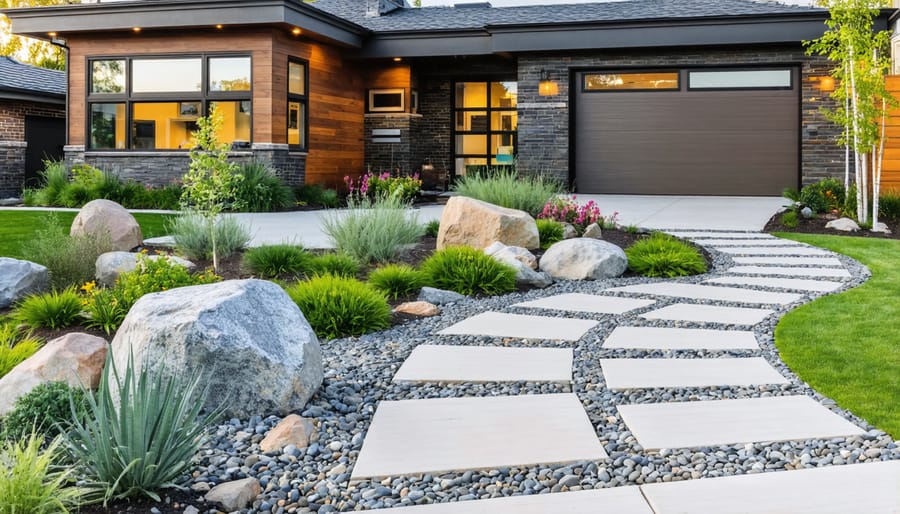
Permanent Pathways and Borders
Creating durable pathways and borders is essential for a low-maintenance front yard that stays beautiful year after year. Opt for materials like stamped concrete, natural stone pavers, or composite decking that can withstand harsh weather conditions and heavy foot traffic. These materials not only look great but also prevent weed growth and require minimal upkeep.
When installing pathways, start with a solid foundation by excavating 6-8 inches deep and laying a base of crushed stone or gravel. This crucial step ensures proper drainage and prevents settling or shifting over time. Edge your pathways with aluminum or steel edging strips that create clean lines and keep materials contained.
For borders, consider installing permanent landscape edging made from concrete, steel, or recycled plastic. These materials create distinct boundaries between different areas of your yard and prevent grass from encroaching into garden beds or gravel areas. Pre-cast concrete curbing is particularly effective and can be customized to match your home’s exterior.
Pro tip: Include subtle lighting along pathways by installing low-voltage LED fixtures during construction. This not only enhances safety but also adds evening curb appeal without creating additional maintenance tasks.
Remember to slope pathways slightly away from your house (about 1 inch per 8 feet) to ensure proper drainage and protect your foundation. Choose non-slip materials in regions that experience frequent rain or snow to maintain safety year-round.
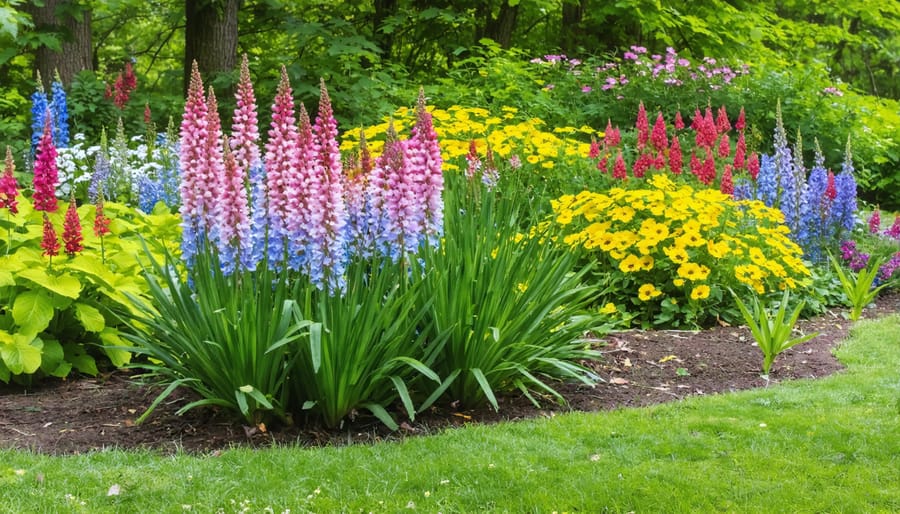
Native Plants That Thrive on Neglect
Ground Covers That Suppress Weeds
Ground covers are your secret weapon in creating a low-maintenance front yard that naturally keeps weeds at bay. These hardy plants spread across the soil, creating a dense carpet that leaves little room for unwanted vegetation to take hold.
Creeping Thyme is a top performer, offering a fragrant, purple-flowering carpet that can handle moderate foot traffic. It stays low to the ground and spreads quickly, making it perfect for filling spaces between stepping stones or covering larger areas.
For shaded areas, consider Pachysandra or Vinca minor (Periwinkle). Both create thick, evergreen coverage and thrive in spots where grass struggles to grow. Pachysandra forms a solid mat of glossy leaves, while Vinca adds delicate blue flowers in spring.
Sedum (Stonecrop) varieties are excellent choices for sunny spots. These succulent ground covers come in various colors and heights, require minimal water, and create a thick barrier against weeds. ‘Dragon’s Blood’ sedum is particularly effective, with its rich burgundy foliage that turns brilliant red in fall.
Sweet Woodruff works wonders in damp, shady areas, producing delicate white flowers and releasing a pleasant hay-like scent when crushed. For slopes or banks, consider Creeping Juniper, which not only prevents weeds but also helps prevent soil erosion.
Remember to prepare your soil properly before planting and space your ground covers according to their mature spread. While these plants may take a season or two to establish fully, they’ll reward you with years of natural weed suppression and visual interest.
Perennial Plants for Year-Round Appeal
Transform your front yard into a low-maintenance paradise with carefully selected perennials that offer year-round visual interest. These hardy plants are the cornerstone of sustainable landscaping design, providing lasting beauty without constant attention.
Consider incorporating ornamental grasses like Blue Fescue or Maiden Grass, which maintain their structure throughout winter and only need annual trimming. Lavender adds both color and fragrance while thriving in sunny, well-drained locations with minimal water requirements. For shaded areas, Hostas and Hellebores offer lush foliage and winter blooms respectively, naturally repelling deer and requiring little more than occasional mulching.
Drought-resistant options like Sedum and Russian Sage provide stunning blooms and attract pollinators while being virtually indestructible. Black-Eyed Susans and Coneflowers deliver reliable summer color and self-seed readily, creating natural colonies that suppress weed growth. For ground cover, Creeping Thyme and Lamb’s Ears spread efficiently, choking out weeds while adding textural interest.
Layer these perennials according to height and bloom time to ensure visual interest across seasons. Place taller plants like Joe Pye Weed at the back of beds, medium-height flowers in the middle, and spreading ground covers at the front. Group plants with similar water needs together to maximize irrigation efficiency.
Remember to mulch well during planting and refresh annually – this simple step dramatically reduces watering needs and weed growth while improving soil health. With these hardy perennials in place, your front yard will flourish with minimal intervention, providing years of beauty and environmental benefits.
Smart Irrigation Solutions
Self-Regulating Drip Systems
A self-regulating drip system is one of the most effective sustainable home solutions for maintaining a beautiful front yard with minimal effort. These smart irrigation systems deliver water directly to your plants’ roots, eliminating waste and ensuring optimal moisture levels without your constant supervision.
Installation is surprisingly straightforward: simply connect the main line to your water source, lay out the tubing along your planted areas, and attach drip emitters near each plant. Modern systems come with smart controllers that automatically adjust watering schedules based on weather conditions, soil moisture, and seasonal changes.
The benefits are impressive: you’ll save up to 70% on water usage compared to traditional sprinklers, prevent weed growth by targeting water only where needed, and protect your plants from both under and overwatering. Many systems can be controlled through smartphone apps, allowing you to monitor and adjust settings even when you’re away.
For best results, combine your drip system with moisture-retaining mulch and group plants with similar water needs together. This setup practically eliminates the need for manual watering while keeping your landscape healthy and vibrant year-round.
Rain Gardens and Natural Water Management
Rain gardens are nature’s solution to water management, offering a beautiful way to handle runoff while creating a self-sustaining ecosystem in your yard. These shallow depressions, strategically placed to catch water from downspouts or natural slopes, work wonders in reducing maintenance needs and supporting local wildlife.
To create your own rain garden, start by identifying the natural water flow in your yard. Choose native plants that thrive in both wet and dry conditions – think rushes, sedges, and moisture-loving perennials. These plants develop deep root systems that help filter water and prevent erosion, practically maintaining themselves once established.
Consider incorporating a dry creek bed with decorative rocks and pebbles to guide water flow naturally. This not only looks stunning but also prevents water pooling in unwanted areas. For added efficiency, position your rain garden at least 10 feet from your house’s foundation and in a spot where it can naturally collect water.
The beauty of rain gardens lies in their self-regulating nature. Once properly installed, they require virtually no maintenance beyond occasional debris removal. They naturally filter pollutants, reduce flooding risks, and create a haven for beneficial insects and birds – all while adding an eco-friendly focal point to your zero-maintenance landscape.
Maintenance-Free Lawn Alternatives
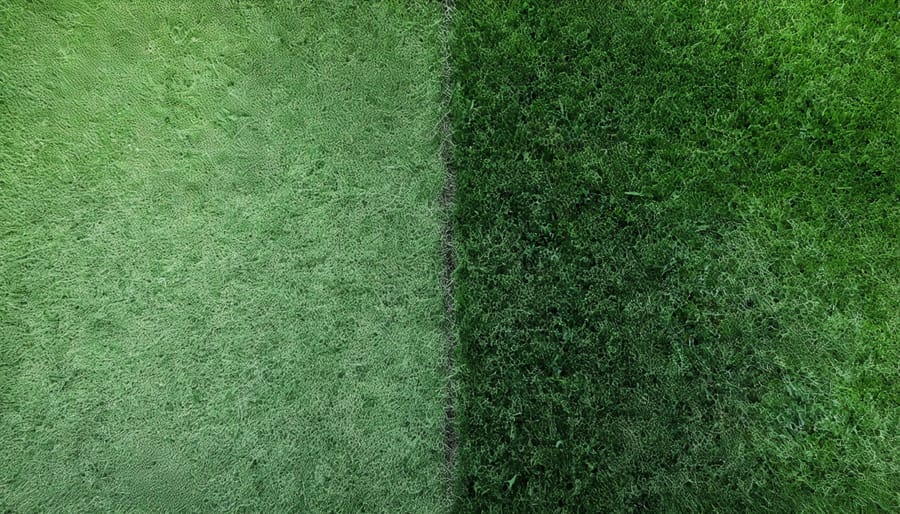
Artificial Turf Options
Today’s artificial turf options are a far cry from the plasticky-looking surfaces of the past. Modern synthetic grass provides a realistic, lush appearance while requiring virtually no maintenance. Available in various blade lengths, colors, and textures, you can choose options that perfectly match your desired aesthetic.
When selecting artificial turf, consider features like UV protection to prevent fading, antimicrobial treatments to inhibit bacteria growth, and proper drainage systems. Premium varieties often include multi-colored blades and thatch layers that create a more natural look, complete with slight variations in color and texture.
Installation typically involves removing existing grass, creating a stable base with crushed stone or sand, and laying a weed barrier. The turf is then rolled out, secured at the edges, and filled with infill material to help blades stand upright. While professional installation is recommended for optimal results, experienced DIYers can tackle this project with proper planning.
Key benefits include:
– No mowing, watering, or fertilizing needed
– Year-round green appearance
– Pet-friendly options available
– Excellent drainage capabilities
– Durability lasting 15-20 years
To maintain your artificial lawn, occasional brushing and rinsing to remove debris is all that’s typically needed. While the initial investment may be higher than natural grass, the long-term savings in water, equipment, and maintenance make it an economical choice for a zero-maintenance yard.
Natural No-Mow Alternatives
Looking to ditch your lawn mower for good? Natural no-mow alternatives offer a beautiful, sustainable solution for your front yard. Creeping ground covers like thyme, clover, and sedum create lush carpets that only grow a few inches tall, naturally maintaining their height without any trimming needed.
Ornamental grasses like blue fescue and sedge provide year-round visual interest while staying compact. These grasses typically reach their maximum height and simply wave gracefully in the breeze rather than continuing to grow taller. For shady areas, moss can create a enchanting emerald carpet that thrives without maintenance.
Native wildflower meadows offer another stunning option. Once established, they create a self-sustaining ecosystem that supports local pollinators. Choose a mix of perennial varieties that naturally reseed themselves for years of colorful blooms without replanting.
For areas with minimal foot traffic, consider buffalo grass or fine fescue varieties specifically bred to grow slowly and stay short. These grass alternatives only reach about 4-6 inches in height, eliminating the need for regular mowing.
Remember to check local regulations before making the switch, as some communities have specific rules about front yard landscaping. Whichever option you choose, prepare your soil properly and plan for some initial maintenance during the establishment period. Once your no-mow alternative takes root, you’ll enjoy a beautiful, low-maintenance yard that practically takes care of itself.
Creating a zero-maintenance front yard isn’t just about reducing work – it’s about reclaiming your time while maintaining a beautiful, welcoming home exterior. By implementing the strategies we’ve discussed, from selecting drought-resistant plants to incorporating hardscaping elements and installing smart irrigation systems, you can transform your yard into a sustainable, low-effort space that brings joy rather than endless chores.
Remember that the transition doesn’t have to happen all at once. Start with small changes, like replacing high-maintenance plants with native species or installing a section of permeable pavers. As you become more comfortable with these modifications, you can gradually expand your zero-maintenance zones until your entire front yard requires minimal care.
The initial investment in materials and planning will pay off many times over through reduced water bills, eliminated lawn care costs, and countless hours saved on maintenance. Plus, you’ll be contributing to environmental sustainability while setting a positive example in your neighborhood.
Take the first step today by assessing your current yard and identifying areas where you can begin implementing these changes. With proper planning and the right choices, you can create a front yard that’s not only beautiful and environmentally friendly but also gives you the freedom to spend your weekends doing what you love instead of tending to endless yard work.

